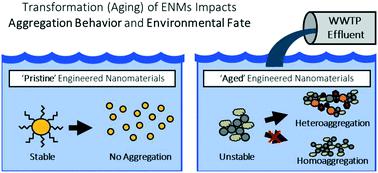当前位置:
X-MOL 学术
›
Environ. Sci.: Nano
›
论文详情
Our official English website, www.x-mol.net, welcomes your feedback! (Note: you will need to create a separate account there.)
Comparing the fate of pristine and wastewater-aged gold nanoparticles in freshwater
Environmental Science: Nano ( IF 7.3 ) Pub Date : 2021-3-26 , DOI: 10.1039/d1en00156f Mark C. Surette 1, 2, 3, 4 , Campbell J. McColley 1, 2, 3, 4 , Jeffrey A. Nason 1, 2, 3, 4
Environmental Science: Nano ( IF 7.3 ) Pub Date : 2021-3-26 , DOI: 10.1039/d1en00156f Mark C. Surette 1, 2, 3, 4 , Campbell J. McColley 1, 2, 3, 4 , Jeffrey A. Nason 1, 2, 3, 4
Affiliation

|
The surface coatings applied to engineered nanomaterials (ENMs) during their manufacture have been shown to affect their aggregation behavior in aquatic media. This phenomenon has important implications on the environmental fate of ENMs and is often examined using ENMs in their ‘pristine’ form. However, the physiochemical properties of ENMs will be altered during their life cycle. Engineered systems, such as sewers and wastewater treatment plants, represent one pathway wherein ENMs can be transformed prior to their release. The focus of the current study was to compare the aggregation behavior of ‘pristine’ and ‘wastewater-aged’ ENMs in freshwater to provide insights into the impact of wastewater aging on ENM environmental fate. Gold nanoparticles (AuNPs) coated with polyethylene glycol (PEG), lipoic acid (COOH) and branched polyethylenimine (bPEI) were selected as model ENMs. The AuNPs were aged in filtered primary wastewater using a previously reported technique. The aged and pristine AuNPs were dosed into separate samples of raw and filtered freshwater and the loss of AuNPs from suspension by aggregation and sedimentation quantified using inductively coupled plasma mass spectrometry. Regardless of the initial surface coating, the AuNPs homoaggregated and acquired an organic matter corona while aging in the wastewater media. Following dispersion in the raw and filtered river water, the aged AuNPs were consistently lost from suspension. Greater loss was observed in the raw river water compared to the filtered river water, demonstrating that the aged AuNPs undergo heteroaggregation in addition to the homoaggregation that occurred during the aging process. This contrasts with the behavior of the pristine AuNPs, which were generally resistant to aggregation. These results indicate that while the physiochemical properties of the pristine AuNPs largely prevent their aggregation and subsequent sedimentation in the river water, the stabilizing effects of the engineered surface coatings examined in this study are lost after aging in wastewater. This demonstrates the importance of explicitly accounting for ENM transformations when designing experiments and selecting materials intended to elucidate the factors impacting ENM environmental fate.
中文翻译:

比较原始和废水老化的金纳米颗粒在淡水中的命运
研究表明,在工程纳米材料(ENM)的制造过程中施加的表面涂层会影响其在水介质中的聚集行为。这种现象对ENM的环境命运具有重要影响,并且经常使用“原始”形式的ENM对其进行检查。但是,ENM的理化特性将在其生命周期中发生变化。工程系统,例如下水道和废水处理厂,代表了一种途径,在此途径中,ENM可以在释放前进行转化。当前研究的重点是比较“原始”和“废水老化”的ENM在淡水中的聚集行为,以提供有关废水老化对ENM环境命运的影响的见解。涂有聚乙二醇(PEG)的金纳米颗粒(AuNP),选择硫辛酸(COOH)和支链聚乙烯亚胺(bPEI)作为模型ENM。使用先前报道的技术,将AuNPs在过滤后的一级废水中老化。将老化的和原始的AuNPs分别分配到原水和过滤后的淡水样品中,并使用电感耦合等离子体质谱法定量分析通过聚集和沉淀从悬浮液中损失的AuNPs。无论最初的表面涂层如何,AuNP都会聚集并在废水介质中老化的同时获得电晕物质。分散在原水和过滤后的河水中后,老化的AuNPs一直因悬浮而丢失。与过滤后的河水相比,原河水的损失更大,证明了老化的AuNP除了在老化过程中发生的均聚之外,还经历了异质聚集。这与通常对聚集具有抗性的原始AuNP的行为相反。这些结果表明,虽然原始AuNPs的物理化学性质在很大程度上防止了它们的聚集和随后在河水中的沉淀,但在废水中老化后,本研究中研究的工程表面涂层的稳定作用消失了。这证明了在设计实验和选择旨在阐明影响ENM环境命运的因素的材料时,明确考虑ENM转换的重要性。这些结果表明,虽然原始AuNPs的物理化学性质在很大程度上防止了它们的聚集和随后在河水中的沉淀,但在废水中老化后,本研究中研究的工程表面涂层的稳定作用消失了。这证明了在设计实验和选择旨在阐明影响ENM环境命运的因素的材料时,明确考虑ENM转换的重要性。这些结果表明,虽然原始AuNPs的物理化学性质在很大程度上防止了它们的聚集和随后在河水中的沉淀,但在废水中老化后,本研究中研究的工程表面涂层的稳定作用消失了。这证明了在设计实验和选择旨在阐明影响ENM环境命运的因素的材料时,明确考虑ENM转换的重要性。
更新日期:2021-04-01
中文翻译:

比较原始和废水老化的金纳米颗粒在淡水中的命运
研究表明,在工程纳米材料(ENM)的制造过程中施加的表面涂层会影响其在水介质中的聚集行为。这种现象对ENM的环境命运具有重要影响,并且经常使用“原始”形式的ENM对其进行检查。但是,ENM的理化特性将在其生命周期中发生变化。工程系统,例如下水道和废水处理厂,代表了一种途径,在此途径中,ENM可以在释放前进行转化。当前研究的重点是比较“原始”和“废水老化”的ENM在淡水中的聚集行为,以提供有关废水老化对ENM环境命运的影响的见解。涂有聚乙二醇(PEG)的金纳米颗粒(AuNP),选择硫辛酸(COOH)和支链聚乙烯亚胺(bPEI)作为模型ENM。使用先前报道的技术,将AuNPs在过滤后的一级废水中老化。将老化的和原始的AuNPs分别分配到原水和过滤后的淡水样品中,并使用电感耦合等离子体质谱法定量分析通过聚集和沉淀从悬浮液中损失的AuNPs。无论最初的表面涂层如何,AuNP都会聚集并在废水介质中老化的同时获得电晕物质。分散在原水和过滤后的河水中后,老化的AuNPs一直因悬浮而丢失。与过滤后的河水相比,原河水的损失更大,证明了老化的AuNP除了在老化过程中发生的均聚之外,还经历了异质聚集。这与通常对聚集具有抗性的原始AuNP的行为相反。这些结果表明,虽然原始AuNPs的物理化学性质在很大程度上防止了它们的聚集和随后在河水中的沉淀,但在废水中老化后,本研究中研究的工程表面涂层的稳定作用消失了。这证明了在设计实验和选择旨在阐明影响ENM环境命运的因素的材料时,明确考虑ENM转换的重要性。这些结果表明,虽然原始AuNPs的物理化学性质在很大程度上防止了它们的聚集和随后在河水中的沉淀,但在废水中老化后,本研究中研究的工程表面涂层的稳定作用消失了。这证明了在设计实验和选择旨在阐明影响ENM环境命运的因素的材料时,明确考虑ENM转换的重要性。这些结果表明,虽然原始AuNPs的物理化学性质在很大程度上防止了它们的聚集和随后在河水中的沉淀,但在废水中老化后,本研究中研究的工程表面涂层的稳定作用消失了。这证明了在设计实验和选择旨在阐明影响ENM环境命运的因素的材料时,明确考虑ENM转换的重要性。



























 京公网安备 11010802027423号
京公网安备 11010802027423号